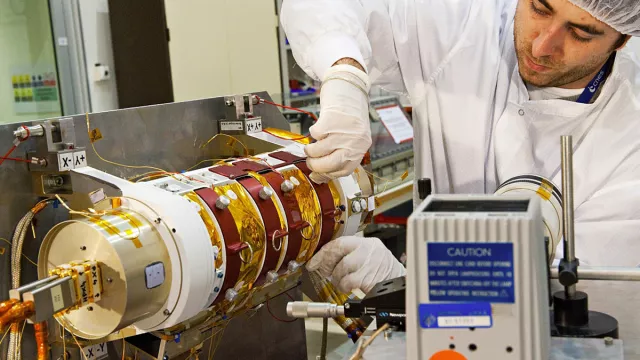The energy exchanged between Earth and space was first estimated at the turn of the century. However, the ScaRaB instrument precisely mapped the planet’s radiation budget and its variations for 20 years.
Key information
| Mission | Measure Earth’s radiation budget and monitor its climate system |
|---|---|
| Domain | Earth observation |
| Launch date | First instrument launched 25 January 1994 |
| Partners | CNRS |
| Where | Earth orbit on Meteor 3 to 6, Resurs 01 to 4 and Megha-Tropiques |
| Lifetime | Meteor 3-6 (13 months) Resurs-O1-4 (7 months) Megha-Tropiques (10 years) |
| Status | Completed |
Key figures
- 4 channels on ScaRaB radiometer
- 40-km spatial resolution at nadir
- 3,300-km swath
- 40 kg: instrument mass
Key milestones
- December 2021: End of ScaRab-3 mission
- 12 October 2011: ScaRab-3 launched on Megha-Tropiques by PSLV
- April 1999: End of ScaRab-2 mission
- 10 July 1998: ScaRab-2 launched on Russia’s Resurs-01 N4 by Zenit-2
- March 1995: End of ScaRab-1 mission
- 25 January 1994: ScaRaB-1 launched on Russia’s METEOR-3-6 by Tsiklon-3
- December 1988: Agreement between CNES and Russian space agency to carry ScaRaB instruments on Soviet satellites
- October 1987: CNES gives go-ahead to pursue development of ScaRaB
- May 1986: ScaRaB project kicks off
Project in brief
When CNES and CNRS, the French national scientific research centre, gave the go-ahead for the ScaRaB programme (Scanner for Radiation Budget) in 1986 as part of space cooperation efforts between France and Russia, global warming was already becoming a major concern. ScaRaB, designed to determine the contributors to Earth’s radiation budget, therefore followed the recommendations of the World Climate Research Programme (WCRP).
The ScaRaB instrument was a four-channel radiometer capable of measuring incoming energy fluxes (solar radiation absorbed by the Earth system) and outgoing fluxes at the top of the atmosphere (infrared radiation escaping into space). It could thus monitor variations in these energy exchanges over time to gain new insights into Earth’s climate system.
CNRS’s LMD dynamic meteorology research laboratory conceived and developed the ScaRaB instrument with contributions from Russian and German laboratories, as well as the data processing software. CNES coordinated with the Russian and German partners for the first two ScaRaB instruments and then Indian partners for the ScaRaB-3 instrument on the Megha-Tropiques satellite. It also processed and archived ScaRaB data in France and delivered them to users.
CNES’s role
CNES and CNRS are the originators of the ScaRaB programme.
Contacts
Sun, Heliosphere & Magnetospheres subject matter expert
Kader Amsif
E-mail: kader.amsif at cnes.fr
Head of Atmospheric Physics & Meteorology
Adrien Deschamps
E-mail: adrien.deschamps at cnes.fr


